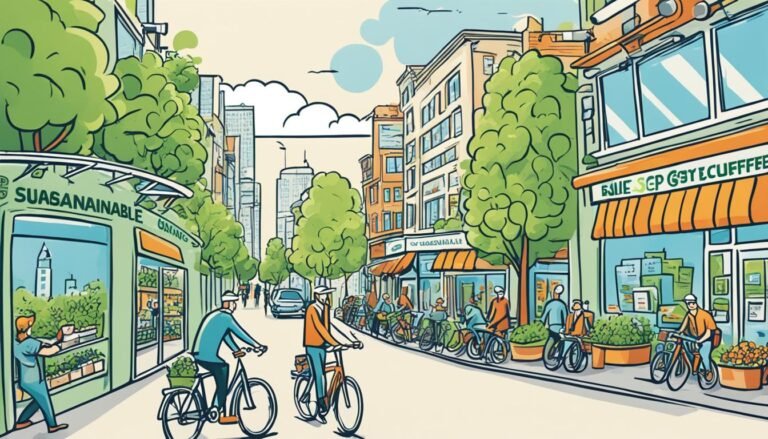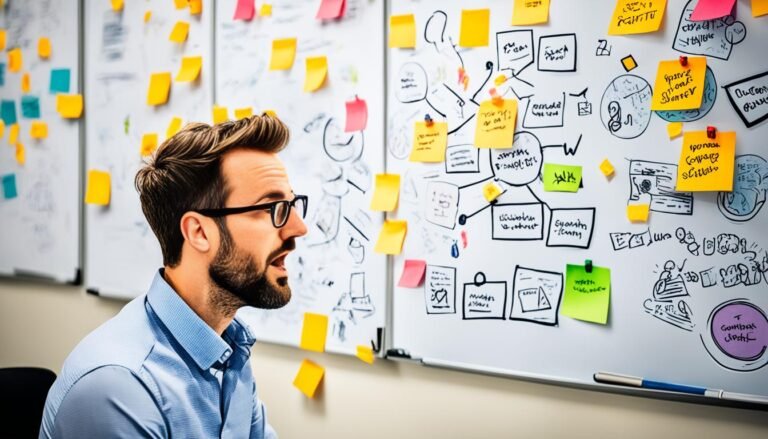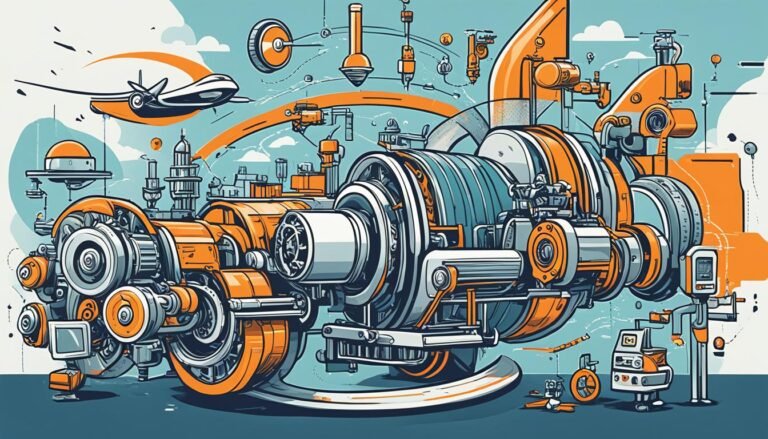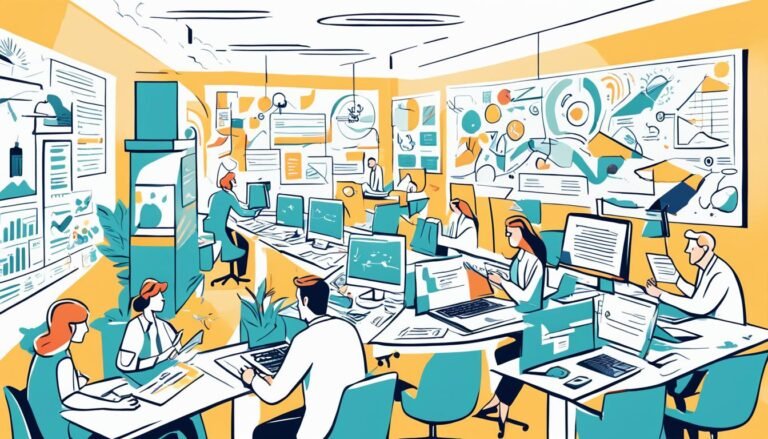Developing Resilience in High-Pressure Creative Roles
Welcome to our guide on becoming more resilient in high-pressure creative roles. In these quick and tough creative jobs, it’s vital to know how to handle stress. We’ll teach you how to stay tough mentally and push through any challenges.
Are you a designer, writer, artist, or work in other creative fields? Learning to be more resilient can make you excel in your job and feel satisfied with your work. We’ll share strategies that can boost your resilience in stressful creative jobs.
Key Takeaways:
- Developing resilience is vital for dealing with stress in creative roles.
- It’s important to build toughness and strategies to handle obstacles, aiding in career success.
- Key steps include managing your energy, creating inspirational goals, and adopting a growth mindset.
- Developing strong relationships, setting boundaries, and taking care of your health are crucial for resilience.
- Emotional agility helps you skillfully manage tough situations with strength and poise.
Defining Resilience in High-Pressure Creative Roles
Starting the journey to build resilience in high-pressure creative roles begins with knowing what resilience means. Resilience means being able to adapt and recover from tough or stressful times. It’s about facing challenges, setbacks, and failures and coming out stronger.
Key elements include:
- Resilience Definition: The ability to bounce back from adversity.
- Mental Toughness: Being strong-minded to thrive under pressure.
- Coping Strategies: Ways to handle stress, like emotional control and problem-solving.
- Managing Stress: Using techniques such as mindfulness to deal with stress.
- Failure Handling: Turning failures into learning opportunities toward growth.
Understanding resilient’s complex nature helps creative professionals approach development comprehensively. By making resilience personal, one can tailor strategies for career success.
In the next part, let’s dive into effective energy management for those in highly demanding creative fields.
The Defining Elements of Resilience in High-Pressure Creative Roles:
| Resilience Component | Description |
|---|---|
| Resilience Definition | The ability to adapt and bounce back from adversity or stressful situations. |
| Mental Toughness | The capacity to persevere and thrive under high-pressure conditions. |
| Coping Strategies | Techniques and approaches to effectively manage stress and navigate challenging situations. |
| Managing Stress | The ability to employ stress management techniques for well-being and resilience. |
| Failure Handling | Embracing failures as opportunities for learning and growth. |
Managing Energy for Resilience in Creative Roles
Creative jobs often bring a lot of stress and pressure. This can lead to feeling drained and burned out. It’s vital to manage our energy well to stay tough and do our best in these tough roles.
Dealing with stress is a big part of this. We need to find ways to lower stress and keep it from piling up. This might mean using methods like deep breaths, meditation, or taking short breaks. It also involves doing things that help us relax, like yoga or mindfulness.
Taking care of ourselves is very important too. We should make sure we get enough sleep, eat well, and do things we enjoy. This helps keep our minds, emotions, and bodies strong so we can face the challenges of our job.
Keeping a good balance between work and personal life is key. It’s important to have time for ourselves, our loved ones, and to rest. Making clear lines between work and personal life helps us recharge. This, in turn, makes us more resilient.
Rejuvenation Activities:
- Engaging in regular exercise to boost physical energy levels and reduce stress.
- Spending time in nature to recharge and gain a fresh perspective.
- Pursuing creative hobbies or activities to stimulate the mind and provide a break from work-related pressures.
- Connecting with loved ones and nurturing social relationships to foster emotional well-being and support.
Adding activities that help us recharge is crucial in creative jobs. Recharging regularly helps keep our energy up. This means we can handle stress better and do well in our jobs.
So, managing our energy well is vital for resilience in creative jobs. This includes good stress management, taking care of ourselves, and keeping a good work-life balance. With these steps, we’re better prepared to succeed in our creative careers.
Setting Inspiring Goals for Resilience in Creative Roles
High-pressure creative roles need inspiring goals to boost resilience. These goals help maintain motivation and drive, keeping you engaged and satisfied. They align your work with personal passions, enhancing resilience.
When setting your goals, think about what really gets you going. Look at your interests and see where you want to improve. Make sure your goals are clear, tough, and doable. This ensures they match what you love and aim for.
Setting these inspiring goals is like charting your creative path. They act as a beacon, guiding you through tough times. Even when challenges and stress come, they keep you focused.
“Setting goals gives you a sense of purpose and something to strive for. It keeps you engaged and motivated, allowing you to push through obstacles and setbacks. When you are working towards goals that truly inspire you, you are more likely to persevere and find satisfaction in your creative role.”
Always check in with your goals to see how you’re doing. Change them if needed and celebrate small wins. This keeps you motivated and makes you stronger.
Goal setting is ongoing. As you meet goals, set new ones that make you stretch and grow. Doing this fuels your passion, creativity, and resilience against challenges.
Remember, resilience is about the journey, not just the final goal. Enjoy the process, learn from your mistakes, and climb higher using those lessons.
Finding Inspiration in Goal Setting
To get inspired with your goals, try these:
- Reflect on your passions: Pinpoint what really drives you in your creative field.
- Observe successful individuals: Find mentors who have made it big and learn from them.
- Seek feedback and guidance: Work with people who can help you set the right goals.
- Visualize your future: Picture where you want to go and what you want to achieve. Let this vision push you to set big goals you can reach.
By setting the right goals, you sync with your passions and boost your resilience in demanding creative work.
Cultivating a Growth Mindset for Resilience in Creative Roles
Cultivating a growth mindset is key for building resilience in creative jobs. This mindset believes people can grow their skills with hard work and learning from mistakes. In creative work, it lets people see failure as a chance to get better.
In tough times, those with a growth mindset don’t give up. They know they can get past the hard parts with hard work and strength. To them, failing at something is a lesson that helps them learn and do better next time.
Learning from mistakes is crucial for a growth mindset. It means looking at what went wrong, learning from it, and doing better next time. This helps people improve their skills and be better prepared for the future.
Jane Martinez, a famous artist and entrepreneur, says, “With every failure comes a lesson. A chance to get closer to success.” She shows us how failures can actually help us if we learn from them.
H3: Perseverance and Resilience Building
Perseverance is critical for a growth mindset. It means pushing through even when things get tough. Building perseverance helps you bounce back from failure and keep going strong.
For those with a growth mindset, failure isn’t the end. It’s a chance to improve and grow. They look at challenges as ways to be more creative and get better.
Matthew Johnson, an entrepreneur and author, thinks a growth mindset is vital in creative jobs. He says, “Being resilient means learning from your mistakes and getting back up stronger.”
H3: Techniques for Cultivating a Growth Mindset
To develop a growth mindset, try these tips:
- Think about what you believe and change any fixed thoughts to ones that grow.
- Set goals that are realistic and focus on the process of getting better.
- Listen to feedback and criticism as chances to learn and grow.
- Try new things and step out of what you’re used to.
- Be proud of small wins to boost your confidence in learning and growth.
- Surround yourself with people who encourage and push you to be your best.
By using these ideas and having a growth mindset, you can handle the tough times in creative jobs better. Believing in your power to learn and grow helps you face problems, handle new things, and do better over time.
Building Supportive Relationships in Creative Roles
Creating a strong support network is crucial for people in creative jobs. Mentors, as well as peers and colleagues, offer help, advice, and understanding. This support can make a big difference in facing tough challenges.
These relationships are essential for building resilience. Mentors, especially, use their experience to guide you. They share strategies to overcome hurdles and stay motivated in your career.
“A mentor’s advice has been key in my creative career. Their wisdom kept me going when times were tough.”
Talking to peers in similar roles is also beneficial. It lets you swap stories, tips, and encouragement. This networking makes you feel part of a supportive community, lessening the feeling of isolation.
Support in the industry opens doors to work together or grow professionally. Connecting with others supports your journey through the challenges of creative work.
It’s vital to ask for help when you need it. This shows strength, not weakness. Seeking advice from those you trust is part of maintaining resilience.
Cultivating a Supportive Network
To create supportive connections in the creative field, remember these tips:
- Join networking events to meet industry professionals.
- Find mentors who inspire and guide you towards your goals.
- Connect with peers facing similar career challenges.
- Always be open to feedback and lend support to others.
- Encourage a collaborative spirit in your workplace.
- Helping others strengthens your network of support.
By actively nurturing relationships and seeking help when necessary, your resilience grows. These interactions offer advice and compassion, vital for success in creative fields.
Setting Healthy Boundaries in Creative Roles
Setting healthy boundaries is key in high-pressure creative jobs. It allows individuals to maintain their well-being and avoid burnout. Practicing time management and separating work from personal life helps reduce stress and build resilience.

Finding work-life balance involves giving time and effort to work and life outside it. This means creating a schedule where work doesn’t take over. It’s about making time for work, hobbies, relaxation, and loved ones to stay balanced and avoid burnout.
Managing time well is crucial for setting boundaries and lowering stress. By setting realistic goals and avoiding too many commitments, you lessen your workload. This leaves time for self-care and helps you keep a balanced and resilient work-life mix.
Remember, setting healthy boundaries doesn’t mean neglecting work or shying away from responsibilities. It simply means recognizing your needs and establishing limits to protect your well-being.
One major advantage of healthy boundaries is lower stress. When work and personal time are clearly separated, you can fully relax when not working. This helps reduce stress and builds resilience.
Benefits of Setting Healthy Boundaries:
- Prevents burnout and exhaustion
- Promotes work-life balance
- Reduces overall stress levels
- Fosters self-care and well-being
- Enhances focus and productivity
Healthy boundaries help those in creative jobs stay well and balanced. By setting these limits, managing time well, and reducing stress, they can be stronger. These steps aid in facing challenges with more resilience and success.
Strategies for Setting Healthy Boundaries
| Strategies | Description |
|---|---|
| Establish Clear Work Hours | Set specific work hours and share them with others to cut down on distractions outside those times. |
| Create a Dedicated Workspace | Choose a space just for work to draw a clear line between work and personal life. |
| Communicate Boundaries | Talk about your limits with coworkers, clients, and family to help them understand your needs. |
| Prioritize Self-Care | Make time for activities like exercise, hobbies, and spending time with family to keep yourself healthy. |
| Practice Saying No | Say no to extra work or projects that could overwhelm and disrupt your balance. |
| Limit Screen Time | Decide how much time you spend online, for work and personal use, to keep a healthy balance. |
Prioritizing Physical Well-Being for Resilience in Creative Roles
Staying healthy physically is key for those in demanding creative jobs. Being in top physical shape helps manage stress and focuses better. It also aids in quicker recovery from tough moments.
Sleep
Sleep is vital for both body and mind. It sharpens thinking, memory, and how well you do overall. It’s also key in handling emotions and stress. Good sleep makes people more resilient for their creative tasks.
Exercise
Moving your body regularly is great for withstanding pressure in creative work. Exercise boosts both physical health and mood. Activities like yoga or dancing help reduce stress and increase focus. They also make you stronger emotionally.
Nutrition
Eating balanced meals supports both body and mind. The food we eat impacts energy, mood, and health. Choosing foods like fruits, veggies, and lean meats gives the energy needed to face creative challenges.
By focusing on sleep, exercise, and good food, people can amp up their resilience. They will be better prepared to handle the tests their creative jobs bring.
Those in high-pressure creative fields know physical and mental resilience go hand-in-hand. When they take care of their health, they’re ready to face any challenges. This approach gives them the strength they need.
Developing Emotional Agility in Creative Roles
Developing emotional agility is key for those in high-pressure creative jobs. It means understanding and handling feelings well. This helps people stay strong and calm in tough times. Through knowing themselves and using techniques to control feelings, they can succeed in creative jobs.
Self-awareness is crucial for emotional agility. It’s about knowing your own thoughts and feelings. When people are in touch with their emotions, they can tackle work challenges better. They have the power to choose how to act, even when emotions are strong.
Controlling emotions is also vital. It’s about managing feelings in a positive way. This helps people stay focused and calm even when things get hard. Practices like deep breathing and positive self-talk can help keep emotions in check.
Emotional agility is about using tough emotions to grow stronger, not avoiding them.
Emotional agility helps build resilience. This means seeing challenges as chances to get better. Instead of feeling down after a failure, they learn from it. This approach makes it easier to handle changes and unknowns in their work.
In addition, emotional agility improves how people work with others. It makes them better at understanding and helping their team. Good relationships and clear communication make a strong support network. This support helps in handling stress in creative jobs.
The Benefits of Developing Emotional Agility
Developing emotional agility in creative jobs brings many advantages. It lets individuals:
- Stay strong and calm in difficult situations
- Make better decisions by understanding themselves more
- Keep focus and perform well when under pressure
- Be ready for any changes with an open mind
- Work well with others and form strong teams
Conclusion
Being resilient is key in creative jobs with lots of stress. To boost resilience, it’s vital to know what it means and how to manage your energy. It’s also about setting inspiring goals, having a growth mindset, and fostering supportive relationships.
With resilience, one can handle stress and challenges well. They can find joy in their creative work. Resilient people can stay calm in tough times, get back up after failing, and keep going strong. This helps them not just survive but flourish in their roles.
By being aware of themselves, taking care, and staying positive, folks can get past hurdles and do well in their jobs. Let’s choose to be resilient and reach our highest potential in creativity, even under pressure.








